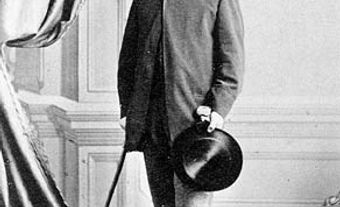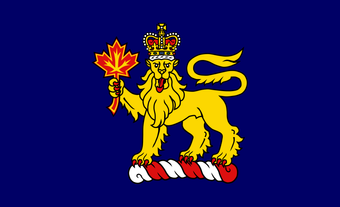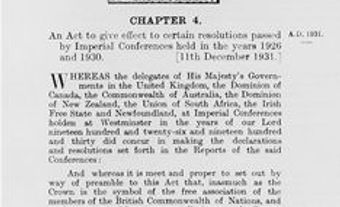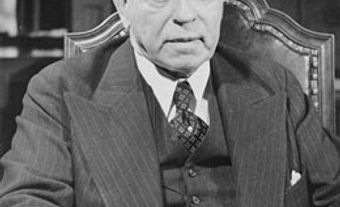Freeman Freeman-Thomas, Baron Willingdon of Ratton and 1st Marquess of Willingdon, governor general of Canada from 1926 to 1931 (born 12 September 1866 in Ratton, United Kingdom; died 12 August 1941 in London, United Kingdom). Willingdon was the first governor general to represent the Canadian Crown rather than the British government following the Balfour Report of 1926. He was also the first to undertake official foreign visits and the first to travel in Canada by air.

Family and Education
Willingdon was the only son of Freeman Frederick Thomas (1838–68), an officer in the rifle brigade of Ratton and Yapton and an accomplished cricket player, and the Honourable Mabel Brand (1845–1924), the third daughter of Henry Brand, 1st Viscount Hampden, Speaker of the House of Commons from 1872 to 1884. He had three sisters, Florence, Margaret and Helen. Willingdon received his secondary education at Eton College and attended Trinity College Cambridge from 1886 to 1889, becoming captain of the cricket team in his final year.
Marriage and Children
On 20 July 1892, Willingdon married the Honourable Marie Adelaide Brassey, the fourth daughter of Thomas Brassey, 1st Earl Brassey, a Liberal member of the British Parliament and governor of the colony of Victoria in Australia from 1895 to 1900, and Anna Allnutt, author of the bestselling travel memoir A Voyage in the Sunbeam: Our Home on the Ocean for Eleven Months (1878). Marie Adelaide’s paternal grandfather, also named Thomas Brassey, was the civil-engineering contractor who built the Grand Trunk Railway of Canada. The marriage was a happy one, and Willingdon later reflected, “My wife has been a constant inspiration and encouragement.”
They had two sons: the Honourable Gerard Frederick Freeman-Thomas (1893–1914), a Second Lieutenant of the 1st Battalion Coldstream Guards, was killed at the Battle of the Aisne during the First World War and Inigo Brassey Freeman-Thomas, 2nd Marquess of Willingdon (1899–1979), served as the Liberal whip in the British House of Lords from 1948 to 1950.
Early Political and Diplomatic Career
From 1897 to 1900, Willingdon served as an aide-de-camp to his father-in-law, who was governor of Victoria in Australia. He was elected to the British House of Commons as a Liberal member of Parliament representing Hastings in 1900 and served as junior lord of the treasury from 1905 to 1906. From 1913 to 1918, Willingdon served as the governor of Bombay, focusing on the recruitment and support of Indian troops during the First World War. He founded The Willingdon Sports Club, which was open to both British and Indian members. From 1919 to 1924, Willingdon served as the governor of Madras. He led the Indian delegation to the League of Nations in 1925.
In 1910, Willingdon became a lord-in-waiting to King George V and received the title of Baron Willingdon of Ratton. He developed a strong rapport with the monarch. Both Willingdon and the king were enthusiastic tennis players and often played together. The King personally recommended Willingdon for the position of governor general of Canada. Canadian Prime Minister William Lyon Mackenzie King favoured Willingdon’s appointment because they were both Liberal politicians.
Governor General of Canada
Lord and Lady Willingdon arrived in Quebec City on 2 October 1926 and received a 19-gun salute from the Citadel. During a welcome ceremony at Le Château Frontenac, Willingdon stated, “From this moment, I am the servant of Canada…for the next five years, it will be my privilege to work with you all in building up Canada as a nation.” Willingdon recognized the potential for Canada to play a peacekeeping role in the world, stating, “I hope and pray that our country may take a long step forward towards the fulfilment of its destiny, that of becoming a great nation, exercising a powerful influence in securing peace and contentment among the people of the world.”
The Balfour Report of 1926 described the United Kingdom, Canada and other self-governing dominions in the Commonwealth as “autonomous communities within the British Empire, equal in status, in no way subordinate to one another in any aspect of their domestic or external affairs.” This made the governor general a representative of the Crown rather than the British government. In this capacity, the Willingdons entertained numerous foreign political figures at Rideau Hall, including Queen Marie of Romania and British Prime Minister Ramsay MacDonald.
Willingdon travelled extensively in Canada, visiting the Prairie provinces and Pacific Coast every year of his term as governor general and paying frequent visits to the Maritime provinces. He was the first governor general to travel by air, travelling from Ottawa to Montreal and back in 1927. He received honorary doctor of laws degrees from Queen’s University and the University of Toronto.
On 11 June 1929, Willingdon opened the Royal York in Toronto (then a Canadian Pacific Railway hotel, now the Fairmont Royal York) and checked into the hotel as its first official guest.

60th Anniversary of Confederation
In July 1927, Willingdon presided over celebrations of Canada’s diamond jubilee, the 60th anniversary of Confederation in 1867. He hosted an official visit by British Prime Minister Stanley Baldwin and two of King George V’s sons, the future King Edward VIII and Prince George, Duke of Kent, who opened the Princes’ Gates at the Canadian National Exhibition in Toronto and the Peace Bridge over the Niagara River. Willingdon dedicated the new Peace Tower on Parliament Hill and inaugurated the Carillon. The ceremony and the ringing of the bells were broadcast on the radio.

Visit to the United States and Caribbean
In December 1927, Willingdon became the first governor general of Canada to make an official visit to the United States. The visit was organized by future governor general Vincent Massey, who was the first Canadian minister to Washington at the time. The Willingdons were welcomed with cavalry escorts and 21-gun salutes and were the guests of honour at a state dinner hosted by President Calvin Coolidge and First Lady Grace Coolidge at the White House. President Herbert Hoover later stated in 1931, “The relations of Canada and the United States have been happy indeed during your distinguished term as governor general, and we shall always have the most pleasant recollections of your visit to Washington.”
In 1929, Willingdon toured the Caribbean, visiting Trinidad and Jamaica, which were part of the British Empire at the time. Willingdon favoured the British West Indies becoming part of Canada, an initiative favoured by prominent Canadians with business interests in the Caribbean, including Thomas Bassett Macaulay, president of the Sun Life Assurance Company of Canada.
Cultural Activities
Lord and Lady Willingdon were enthusiastic collectors of Chinese and Indian art and decorated Rideau Hall with their acquisitions, including a Madras rosewood table and Chinese lacquer furniture. In 1993, the Long Gallery at Rideau Hall was restored to the Chinese style introduced by the Willingdons.
Willingdon established the Willingdon Arts Competition for excellence in music, literature, painting and sculpture and selected a new location for the National Gallery of Canada on Green Island in the Rideau River. These initiatives lapsed because of the economic conditions of the Great Depression and the end of Willingdon’s term as governor general.
Viceroy of India
In 1931, Willingdon’s term as governor general of Canada came to an end when he received a personal telephone call from King George V, insisting that he become the next Viceroy of India. Three previous governors general of Canada — Lord Dufferin, Lord Lansdowne and Lord Minto —had subsequently served as the Viceroy of India.
The new viceroy, now Earl of Willingdon, favoured constitutional change in India that would allow more provincial autonomy and greater participation in government for Indian political figures, both Hindu and Muslim, which culminated in the Government of India Act, 1935. But he also defended India’s place in the British Empire, which brought him into conflict with Mahatma Gandhi and other advocates for Indian independence. Willington’s term as the Viceroy of India ended in 1936 and he returned to the United Kingdom, receiving the title of Marquess of Willingdon.
Later Life
Willingdon maintained an active diplomatic career in later life, leading a goodwill mission to South America and representing the British government at the 100th anniversary of the Treaty of Waitangi in New Zealand in 1940. Willingdon died of pneumonia at his London residence. His ashes are buried in the nave of Westminster Abbey in London. Mackenzie King reflected, “Lord Willingdon’s passing is a loss to the entire British Commonwealth and to international amity and goodwill. To myself, it is a personal grief. We shared a very close and warm friendship.”
Legacy in Canada
The Willingdon Cup, a trophy donated by Willingdon in 1927, is awarded in golf to the winning interprovincial team at the Canadian Men’s Amateur Championship.
The hamlet of Willingdon, Alberta, which was established in 1927–28 in the Canadian Pacific Railway’s Willingdon subdivision (Lloydminster to Edmonton), was named after Willingdon, as were Mount Willingdon, Alberta, and Willingdon Beach, Powell River, British Columbia. There are schools named after Willingdon in British Columbia and Quebec, a Willingdon Boulevard in Toronto and a Willingdon Avenue in Burnaby, British Columbia.

 Share on Facebook
Share on Facebook Share on X
Share on X Share by Email
Share by Email Share on Google Classroom
Share on Google Classroom




